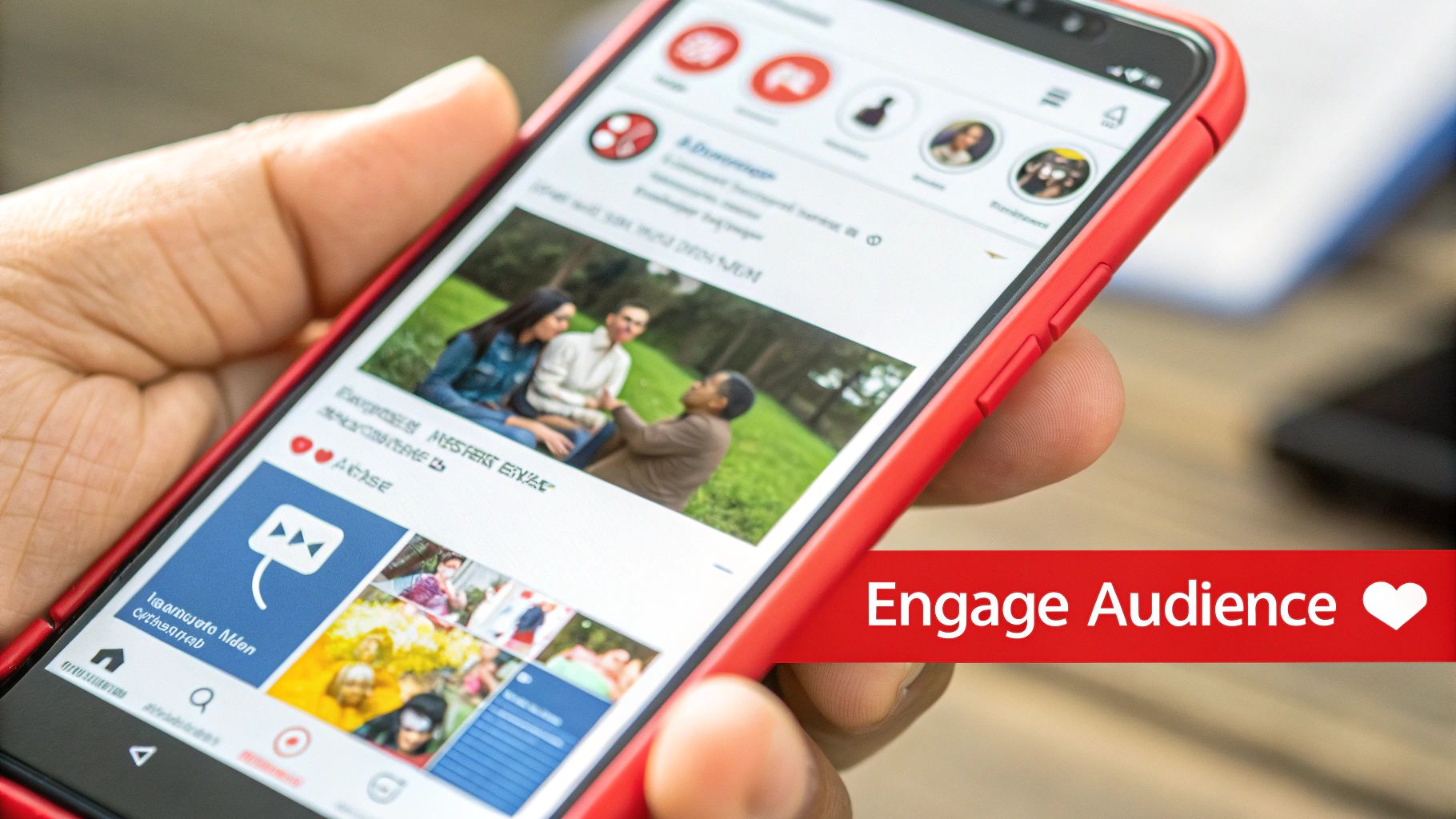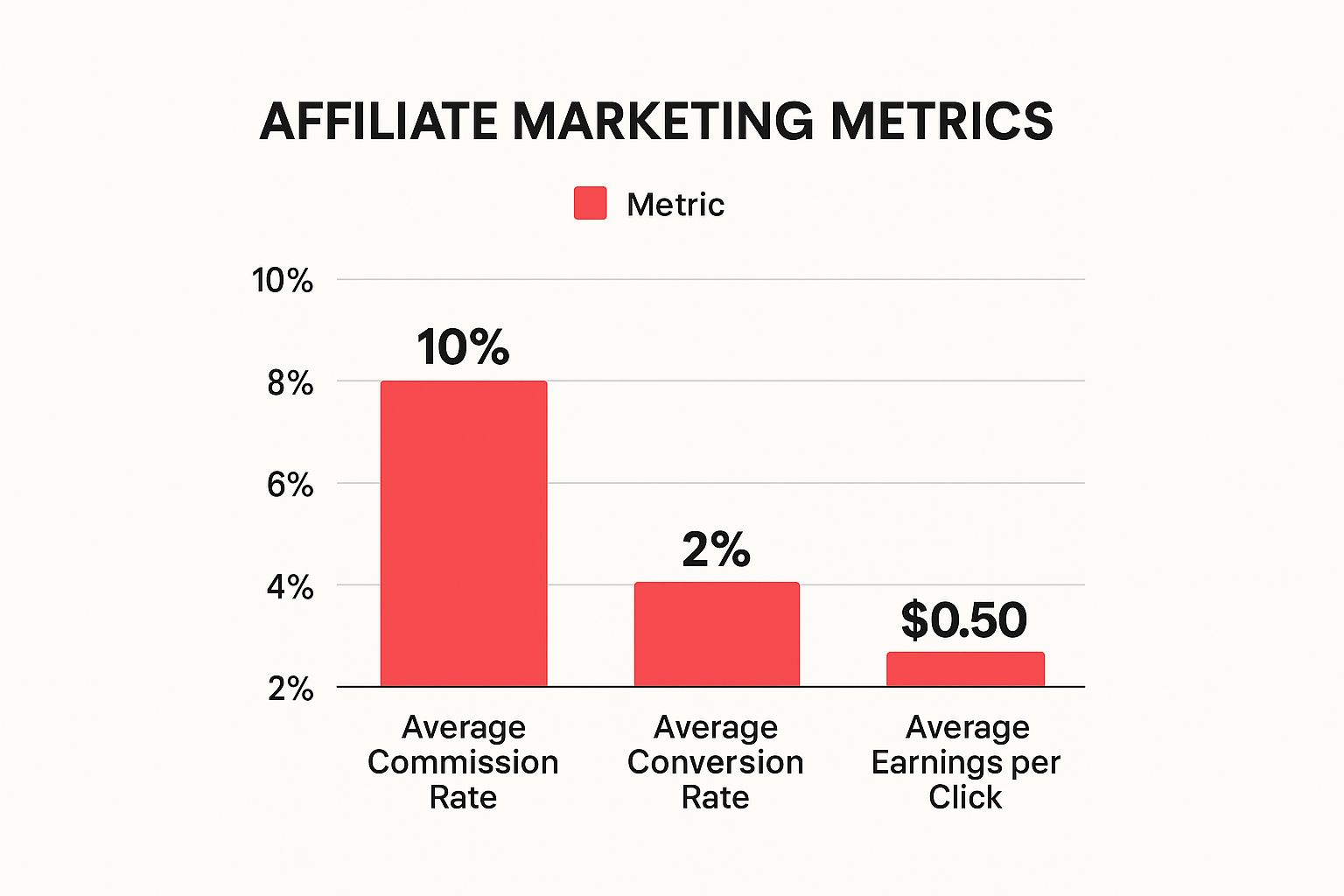The Evolution of Social Media Revenue Streams
Social media has changed dramatically. What started as a simple way to connect and share has become a powerful engine for generating income. This evolution has opened exciting new doors for individuals and businesses to profit from their online presence. It’s been a gradual shift, driven by new platform features, changing consumer behavior, and emerging technologies. Understanding this evolution is crucial for effectively monetizing social media today.
From Connection to Commerce: The Rise of Social Selling
Early social media platforms prioritized community building. Monetization wasn't the main focus. But as platforms grew, so did the potential for revenue. To get a sense of today's landscape, check out examples of how influencers make money. The introduction of advertising was a game-changer. Businesses saw the value of reaching specific audiences through sponsored posts and display ads. This shift laid the foundation for more advanced monetization strategies. The rise of influencer marketing accelerated this trend, with individuals building large followings and partnering with brands.
This shift is reflected in the growth of social commerce. In the U.S., social commerce sales are predicted to exceed $90 billion in 2025, up from nearly $64.8 billion in 2023. This growth is expected to continue, reaching $104 billion in 2028, showing how consumer behavior is changing. People are increasingly buying products directly through social platforms. This makes optimizing social media strategies for sales and revenue even more important. For more statistics, see this Sprinklr blog post.
Diversification Is Key: Exploring Multiple Revenue Streams
Today, social media monetization goes far beyond simple advertising. Creators are using a variety of revenue streams. These include affiliate marketing, where creators earn commissions by promoting products, and direct sales through platform shops and marketplaces. Platforms like Instagram and Facebook offer built-in shopping features. Businesses can now seamlessly integrate e-commerce into their social media presence. This has blurred the lines between social interaction and shopping, creating a more streamlined customer experience.
Subscription models and creator funds are also diversifying the revenue landscape. These programs help creators build recurring income and get direct support from platforms. Social media platforms are investing in creators and creating a more sustainable environment. With new features and tools constantly appearing, it’s an exciting time for anyone wanting to turn their online presence into a profitable business.
Building An Audience Worth Monetizing

Monetizing social media is impossible without an audience. This section explores building a valuable audience that attracts genuine revenue opportunities. We'll cover finding your niche, creating engaging content, and cultivating a community that brands want to partner with. This means prioritizing real engagement, not just vanity metrics.
Identifying Your Unique Positioning
First, identify your target audience. Who are you trying to reach? What are their interests and needs? For example, if your passion is sustainable living, your target audience might be environmentally conscious consumers. Understanding your audience is crucial for creating content that resonates and builds a dedicated following.
Knowing your audience allows you to tailor your message effectively. This targeted approach helps you connect with the right people and foster a loyal following. It's about building a community of individuals genuinely interested in what you have to offer.
Next, define your unique selling proposition (USP). What differentiates you? What value do you bring? Perhaps you offer expert advice on a specific topic. Or maybe your content is known for its humor and relatability. A strong USP helps you stand out online.
Your USP gives your audience a clear reason to follow you. It’s the special something that sets you apart from the competition. This distinct identity is key to attracting and retaining a loyal audience.
Creating Content That Resonates
Understanding your audience and USP allows you to craft compelling content. This means understanding what content works best on each platform. Short-form videos might excel on TikTok, while longer, in-depth content may be better suited for YouTube. Experimentation is essential.
Also, concentrate on providing real value to your audience. This could be through educational content, entertaining videos, or inspiring stories. Valuable content builds trust and strengthens your audience connection, fostering a sense of community.
To help you tailor your content strategy, take a look at the following table. It breaks down platform-specific approaches to help you achieve your monetization goals. It provides insights into content formats, posting frequency, engagement tactics, and key indicators to watch for.
To help illustrate effective strategies across different social media platforms, the following table summarizes key elements for successful audience growth and monetization:
| Platform | Content That Converts | Posting Cadence | Engagement Tactics | Monetization Readiness Indicators |
|---|---|---|---|---|
| TikTok | Short, engaging videos; trending sounds & hashtags | Multiple times per day | Challenges, duets, responding to comments | High engagement, large following, consistent growth |
| YouTube | In-depth tutorials, reviews, vlogs | 1-2 times per week | Q&A sessions, community posts, responding to comments | Watch time, subscriber count, channel memberships |
| High-quality photos & videos; stories; reels | 1-3 times per day | Polls, quizzes, behind-the-scenes content, interacting with other accounts | Engagement rate, follower count, brand partnerships | |
| Text posts, articles, live videos | 1-2 times per day | Group discussions, polls, responding to comments | Group engagement, page likes, boosted posts |
This table offers a general overview, and the optimal approach will vary depending on your specific niche and audience. Analyzing this data can help refine your strategy and focus on the platforms and tactics most likely to yield results.
Building An Engaged Community
Genuine engagement is crucial for monetization. This involves interacting with your followers, responding to comments, and building a sense of community. Think of your social media as a two-way conversation, not just a broadcast.
Running polls and Q&A sessions can boost interaction. Creating challenges or contests can also increase engagement. These activities show your audience they're valued. This transforms passive followers into active participants, making your community highly attractive to brands.
Mastering Social Advertising for Reliable Revenue

Building a thriving online presence is only half the battle. Turning that presence into profit requires a smart advertising strategy. This section explores how successful creators use social media advertising to generate consistent income. We'll go beyond simply boosting posts and dive into platform-specific ad tools and techniques for maximizing your return on investment (ROI) without alienating your audience.
Understanding the Power of Social Media Advertising
Advertising is essential for effectively monetizing social media. In 2025, global spending on social media advertising is projected to reach $276.7 billion. Much of this spending concentrates on mobile platforms, with an estimated 83% of all social media ad spend predicted to be mobile by 2030. Even the average click-through rate (CTR) for Facebook ads, around 2.53%, demonstrates how effective social media advertising can be in reaching target audiences. Find more detailed statistics here. This growth underscores the importance of understanding how to create high-performing ad campaigns.
Building High-Performing Campaigns
Creating effective social media advertising campaigns involves several key elements. First, define clear campaign objectives. What do you want to achieve with your campaign?
Some common objectives include:
- Increasing brand awareness
- Driving website traffic
- Generating leads
Clearly defined objectives are essential for measuring campaign success.
Next, target your audience effectively. Use platform-specific targeting options to reach the right people with your ads. Facebook allows targeting based on demographics, interests, and behaviors. This precision targeting ensures your ads are shown to the most relevant users. Check out our guide on How to master YouTube monetization requirements.
Finally, experiment with different ad formats to see what works best for your audience:
- Video ads: Tell compelling stories and connect with your audience on an emotional level.
- Image ads: Showcase products visually and grab attention quickly.
- Carousel ads: Allow users to swipe through multiple images or videos for a more engaging experience.
Testing different formats helps you identify what resonates best with your audience.
Optimizing for Engagement and ROI
Once your campaigns are running, continuous optimization is key. Monitor key performance indicators (KPIs) like CTR, conversion rate, and cost per click (CPC). Use this data to identify what's working and what isn't. For example, if a particular ad creative isn't performing well, try testing different visuals or messaging.
If your CPC is too high, refine your targeting to reach a more relevant audience. Continuously optimizing your ads is crucial for achieving your desired ROI. Also, consider the user experience. While reaching a large audience is important, avoid overly intrusive advertising tactics. Respect your audience's time and attention by creating ads that are relevant and engaging. This approach fosters trust and strengthens your relationship with your followers, leading to long-term success.
By combining a deep understanding of your audience with smart advertising strategies, you can unlock the full potential of social media monetization.
Turning Followers Into Customers Through Social Commerce

This infographic highlights three key affiliate marketing metrics: average commission rate, average conversion rate, and average earnings per click. While a 2% conversion rate might seem low, combined with a 10% commission rate, it can still generate significant earnings. With enough clicks, you can average $0.50 per click. This underscores the importance of driving traffic and optimizing your content. This section explores how creators are leveraging social media to connect with audiences and convert followers into paying customers. The line between casual browsing and purchasing is blurring, presenting exciting monetization opportunities.
Creating Seamless Buying Experiences
Successful creators are transforming their social media platforms into thriving businesses. They recognize that social commerce goes beyond simply posting product links. It's about crafting a smooth and enjoyable buying experience that integrates seamlessly with the platform. For example, shoppable posts on Instagram allow users to purchase products without leaving the app, increasing the likelihood of a sale.
Effective product presentation is another crucial element. High-quality images, captivating videos, and persuasive descriptions are vital for attracting attention and sparking desire. Consider how fashion influencers effectively showcase clothing and accessories through styling videos and lifestyle photos, making their products more enticing to followers.
Managing Inventory and Fulfillment
Managing inventory efficiently is essential for building trust and satisfying customers. This involves implementing systems to track stock levels, process orders, and handle shipping. This is particularly crucial for creators selling physical goods, where delays or stockouts can negatively impact their reputation.
Even digital product creators need to manage their offerings effectively, ensuring prompt delivery and robust customer support. Addressing these logistical challenges requires careful planning and organization. Partnering with fulfillment services or utilizing inventory management software can streamline operations and create a more professional customer experience.
Leveraging Platform-Specific Techniques
Different social media platforms offer unique tools to boost sales. Shoppable posts, live selling events, and integrated checkout options can significantly improve conversion rates. Live selling creates a sense of urgency, motivating immediate purchases. It functions like a virtual shopping experience, enabling real-time interaction with sellers. You can use a Social Media ROI Calculator to measure the effectiveness of your social advertising.
Creators are continually finding new ways to combine these features to maximize their impact. For example, they might promote products featured in a live selling event through shoppable posts, increasing touchpoints and conversion opportunities. Staying informed about platform best practices helps creators optimize their strategies and maintain a competitive edge. This allows them to create highly targeted campaigns that resonate with their audience and yield measurable results.
To further illustrate successful social commerce strategies, consider the following benchmarks:
To better understand how different platforms perform, let's look at some real-world data. The table below presents key metrics across popular social commerce platforms.
Social Commerce Performance Benchmarks
Real-world conversion data and performance metrics across major platforms
| Platform | Average Conversion Rate | Typical Order Value | Engagement to Purchase Ratio | Top-Performing Product Categories |
|---|---|---|---|---|
| 1.08% | $70 | 2.5% | Fashion, Beauty, Home Decor | |
| 0.50% | $55 | 1.8% | Electronics, Apparel, Food & Beverage | |
| 0.70% | $60 | 2.0% | DIY & Crafts, Home Goods, Fashion | |
| TikTok | 3.00% | $45 | 4.0% | Beauty, Apparel, Tech Gadgets |
This data highlights the varying performance levels across different platforms. Notice the higher conversion rates on platforms like TikTok, where engaging video content drives purchases. Also, consider the differences in average order value and top-performing product categories. Understanding these nuances allows creators to tailor their strategies to each platform, maximizing their return on investment.
Leveraging Platform-Specific Monetization Programs

Beyond common social media monetization methods, many platforms offer built-in programs for creators. These programs can be a significant source of income. Understanding how these programs work, from subscriptions to creator funds and tipping, is crucial for maximizing your earning potential. Let's explore these platform-specific options. For those interested in TikTok, check out this guide on How to get paid on TikTok.
Understanding Creator Funds
Many platforms offer creator funds to support eligible creators. These funds often reward creators based on content performance, such as views, engagement, and reach. However, the criteria and payment structures vary between platforms.
Some platforms might prioritize video content, while others focus on community engagement. Researching each platform's requirements is key to maximizing earnings. Understanding how payouts are calculated is also important. Some offer a fixed rate per view, while others use more complex algorithms based on audience demographics and ad revenue. This knowledge can help shape your content strategy.
Exploring Subscription Models
Subscription models are a great way to build recurring revenue. Platforms like Patreon and OnlyFans allow creators to offer exclusive content to paying subscribers. This could include behind-the-scenes content or early access to new releases.
This model helps build a stronger connection with dedicated followers, offering them premium value for their direct support. A successful subscription model requires understanding your audience's needs and creating compelling offers that justify the cost.
Utilizing Tipping Features
Many platforms have tipping features, enabling audiences to support their favorite creators with monetary contributions. This can be a valuable addition to other income streams, especially for creators with engaged communities.
These features are often integrated directly into the platform, making it easy for viewers to support creators. While individual tips may be small, they can add up over time, especially for creators with large followings. Tipping also builds community and strengthens the creator-audience bond. Social media platforms use various monetization strategies. One is through revenue redistribution, where platforms share revenue with creators. By 2025, these programs are expected to redistribute over $20 billion to millions of accounts. This is in addition to options like fan tips and branded content. Learn more about these evolving strategies here.
Optimizing Your Content Strategy
Earning through platform-specific programs requires a strategic approach to content. It's not just about creating good content; it's about understanding what performs well under each program’s rules. For example, if a platform rewards high engagement, focus on creating content that sparks conversation.
Also, ensure your content aligns with your brand and resonates with your audience. Balancing platform requirements with authenticity is vital for long-term success. Regularly analyze your content's performance to identify areas for improvement and refine your strategy. This ongoing optimization is crucial for maximizing your income.
Crafting Brand Partnerships That Pay What You're Worth
Moving beyond one-off sponsored posts to building profitable, long-term brand relationships requires a strategic approach. This section explores how successful creators develop partnerships that provide reliable income and boost their credibility. We'll cover identifying suitable brands, crafting compelling proposals, negotiating fair deals, and maintaining audience trust.
Identifying Aligned Brands
The first step is identifying brands that align with your values and audience. A mismatch between your content and a brand's identity can damage your credibility and erode audience trust. For example, a fitness influencer partnering with a fast-food chain creates a disconnect that could alienate their followers.
Instead, creators should seek partnerships with brands that offer genuine synergy and provide value to both the creator and the audience. A fitness influencer, for instance, would find better alignment with fitness apparel brands, health food companies, or gyms.
Researching potential partners is crucial. Look at their existing marketing efforts and audience demographics. This research helps determine whether a partnership is a good fit and ensures the collaboration feels authentic and beneficial to everyone involved.
Creating Compelling Partnership Proposals
Once you’ve identified potential partners, create a compelling proposal. This document should clearly outline your audience demographics, engagement rates, and the proposed partnership details. Include clear objectives for the partnership, outlining what both you and the brand hope to achieve.
These objectives might include increased brand awareness, driving website traffic, or generating leads. Quantifiable objectives help both parties measure the partnership's success. A professional media kit showcasing your past work and results can significantly strengthen your proposal.
Negotiating Deals That Reflect Your Value
Negotiating fair deals is essential. Don't undervalue your contribution. Your pricing should reflect your audience reach, engagement levels, and the work involved in the partnership. A creator with a highly engaged audience can often command higher rates than one with a larger but less active following.
Consider different pricing models, such as cost per engagement (CPE) or cost per mille (CPM). CPE focuses on the interactions your content generates, while CPM is based on impressions or views. Choose the model that best reflects your value and aligns with the partnership’s objectives.
Maintaining Audience Trust and Transparency
Balancing sponsored content with audience trust is vital for long-term success. Transparency is key. Clearly disclose sponsored partnerships to maintain authenticity and build trust with your audience. This can involve using clear hashtags like #ad or #sponsored and being upfront about your relationship with the brand.
Focus on partnerships that genuinely benefit your followers. If a sponsored product or service aligns with your niche and provides value to your audience, the partnership will feel more authentic. This authenticity fosters trust and strengthens your relationship with your audience, ultimately leading to greater success in monetizing your social media presence. This approach also strengthens your relationships with brands, positioning you for more lucrative partnerships in the future.
Managing Client Expectations and Building Long-Term Relationships
Managing client expectations is crucial for successful brand partnerships. Maintain open communication with your partners, providing regular updates on campaign performance and addressing any concerns promptly. This proactive approach builds trust and strengthens the working relationship.
Look for opportunities to transform successful collaborations into ongoing revenue streams. A single sponsored post can be the starting point for a long-term partnership. By consistently delivering results and exceeding client expectations, you can build valuable, long-term relationships that lead to repeat business and increased earnings. This consistent performance establishes you as a reliable partner and enhances your reputation.
Building Your Social Media Money Machine
The most successful creators on social media understand the importance of diversified income. They don't rely on a single source. Instead, they build multiple revenue streams to navigate the ever-shifting social media world. This section explores how to create a monetization ecosystem that can withstand platform changes, market fluctuations, and evolving audience tastes.
Combining Revenue Streams for Long-Term Success
Building a successful monetization strategy is similar to building a diversified investment portfolio. Just as you wouldn't put all your eggs in one basket, relying solely on one income source on social media is risky. Imagine depending entirely on a platform's creator fund. If that fund's policies change, your income could vanish overnight.
Diversifying your revenue streams protects you from such risks. By combining income from brand partnerships, affiliate marketing, social commerce, and platform-specific programs, you create a safety net. This allows you to capitalize on various opportunities as they arise and provides a more complete picture of your audience's value. You can also experiment with different models to see which ones resonate most with your followers. Want to learn more? Check out this helpful resource: How to master social media monetization.
Matching Monetization Methods to Your Content and Audience
Different audiences respond to different monetization methods. Some audiences love social commerce, while others prefer creator merchandise. The key is to experiment and find what works best for your community.
Consider your content niche. If you create educational content, affiliate marketing with relevant products might be a natural fit. A strong visual presence might lend itself to selling merchandise or using shoppable posts. For example, a food blogger could use affiliate links for cooking supplies, sponsored posts featuring kitchen appliances, and even sell their own cookbooks.
Think about your audience's demographics and preferences, too. Younger audiences might be more open to microtransactions and virtual gifts, while older audiences might prefer subscriptions or premium products. Understanding these nuances helps you choose the right monetization methods for maximum impact.
Balancing Immediate Revenue and Long-Term Brand Building
Generating immediate revenue is important, but don't neglect the long game of brand building. Focus on creating high-quality content that builds trust with your audience. This fosters a loyal following that is more receptive to your monetization efforts.
Every piece of content is an investment in your brand. Consistent value establishes you as an authority and strengthens your audience relationship, making your monetization efforts more effective.
Adapting to the Ever-Changing Social Media Landscape
Social media is constantly evolving. New features, algorithms, and monetization options appear regularly. Successful creators stay adaptable and continually refine their strategies. This means staying up-to-date on industry trends, experimenting with new approaches, and being open to changing tactics.
Don't be afraid to experiment. The social media landscape is dynamic, and what works today might not work tomorrow. By staying flexible and proactive, you can stay ahead of the curve and continue building your social media money machine.
Ready to kickstart your monetization journey? MonetizedProfiles offers monetization-approved TikTok and YouTube accounts, organically grown and ready to earn ad revenue immediately. Visit MonetizedProfiles today to learn more!








